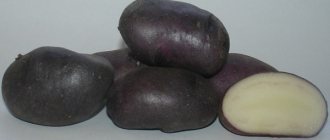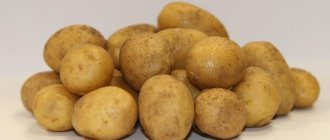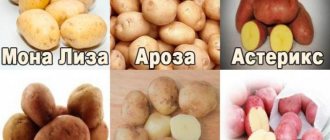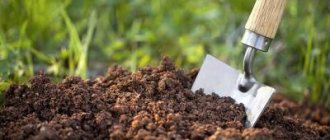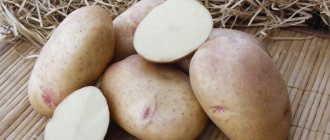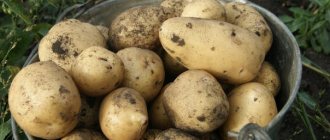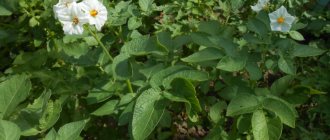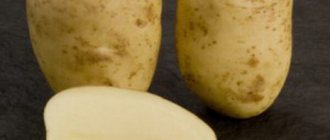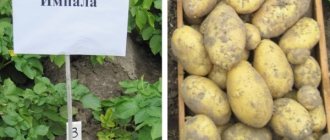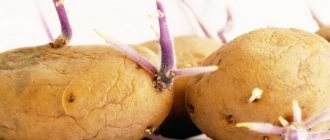It seems that an unspoken competition has developed among breeders for the most beautiful and loud name. In this ranking, the Potato variety Queen Anna , bred relatively recently, claims the right to occupy the top positions. In the next scale - the most delicious root vegetables - potatoes with royal aspirations are also ready to fight for primacy.
And if we add one more characteristic to this - mid-season, we can say with confidence: scientists from Germany who created a new potato variety did not spend years of painstaking work in vain.
Characteristics of tubers
The average weight of potatoes is 100 g. Gardeners know that most often it ranges from 85 to 135 g. One plant produces from 6 to 16 tubers, reaching 10 cm in length. The starch content in root crops is 13 - 14%. It is noted that this indicator depends on weather conditions. In hot weather the percentage rises, in rainy summers it drops.
Potato tubers are oval, slightly elongated. There are few eyes, they are located on the surface, and their size is small. The peel is smooth, the usual yellow color. The pulp of the tubers is creamy and darkens slightly during heat treatment, but this does not affect the quality of the finished product, which practically does not soften during cooking. The fruits of the plant taste slightly sweet, but gourmets are delighted with this. Experts give a high tasting assessment of the culinary qualities of the tubers, giving them an eight on a ten-point scale.
Features of the Queen Anne potato variety affect many characteristics, including:
- high commercial qualities;
- suitability for long-distance transportation;
- resistance to minor damage;
- adaptability to mechanical assembly, washing and packaging.
Characteristics and description of the variety
The Queen Anne bush is medium-sized, with erect stems covered with large, deep green foliage. During flowering, it is covered with small flowers with white petals. Fruits are formed extremely rarely.
Hidden under the bush are elongated oval tubers with smooth and dense skin. The eyes are small and not deep. Both the peel and the pulp are yellow. The pulp is firm, does not overcook, and has excellent taste. Suitable for preparing all kinds of dishes.
Characteristics of the variety:
- tubers are medium, weighing 85–137 g;
- mid-season variety, can be harvested in 80-90 days;
- root vegetables contain 14% starch;
- universal culture.
Mid-season potato varieties also include such as “Slavyanka”, “Kolobok”, “Rokko”, “Skarb”, “Irbitsky”.
How to care for potatoes
The Queen Anna variety does not require much trouble, starting from the first minutes of life. But you can’t leave the plant to chance. Experienced gardeners take care of the future harvest in the fall, removing old grass from the site, digging up the beds and then flavoring the soil with organic fertilizers. If the composition of the soil allocated for the beds is close to acidic, it must be “diluted” with dolomite flour approximately once every three years.
Queen Anne potatoes are unpretentious, but the potato produces a good harvest in fertile soil. For planting, you need open areas; in the shade of trees or next to a fence, the potatoes will be bad, this will affect both their appearance (the leaves will stretch out, the tops will become thinner), and the quality of the tubers - they will not be large.
In early May, the potato beds are dug up again, clearing the ground of weed roots. Add organic matter, compost and saltpeter. Cucumbers, pumpkins, cabbage, and onions are considered good predecessors for potatoes.
Harvesting and storage
They start harvesting the German variety only after the tops die off. Plant residues are first removed from the site, and then digging begins. It is carried out in dry weather. After all the tubers are removed, they are moved to a shaded place, where they dry out for several days and the skin becomes rougher. The latter is a prerequisite for long-term storage.
Tubers are sorted by size as well as quality. Damaged ones are put away in the pantry for prompt use, sick ones are thrown away, planting material is placed in a separate box. The remaining potatoes are distributed into ventilated containers and placed in a dry basement. The temperature for long-term storage of potatoes is maintained at 3 °C.
Potatoes Queen Anne - planting
Planting begins in mid-May, after waiting until the soil warms up to +13+150 C, and there is no danger of new frosts. For the future harvest, you need Queen Anne seed potatoes of small size. The tubers are not cut. It is recommended to carefully inspect each potato - the planting material must be of high quality, free from damage, viruses and insects. Potatoes selected for beds must be treated with boric acid, Maxim or Prestige preparations. This is done to kill germs. Then the tubers are placed in a dark place to dry. Germination is carried out:
- in special plastic bags;
- in boxes;
- scattered on the floor.
During the germination of tubers, sunlight should be avoided. The sprouts should be greenish and strong. When planting Queen Anne potatoes, you should follow the plan. The distance in the beds between future bushes should be 25-30 cm, between the rows - 65-70 cm. It is recommended to place the beds in the direction from north to south so that the sun's rays fall evenly on the plant.
One tuber is lowered into the hole. If there are more, they will interfere with each other. The harvest will be abundant, but the potatoes will grow small. As soon as planting is complete, the potatoes are covered with soil and mulched with peat, sawdust or dry grass. Mulch will not allow weeds to become active in the area.
Agricultural technology
This potato has no special care requirements; Queen Anne is grown using standard technology. You don’t need to put in a lot of effort to get a decent harvest.
Selecting a location
The bed should be well lit from all sides. The best soil for potatoes of any variety is fertile sandy loam, but any soil filled with humus in the fall at the rate of a bucket per 1 square meter will do. m. If necessary, add sand or peat for looseness.
The area must be dug up with a shovel at the end of the previous season. If this is not possible, no later than 2 weeks before planting.
To prevent infection by pests and diseases typical of potatoes, nightshade crops should not grow in the garden bed for at least 3 seasons. You can improve the soil by applying copper-containing preparations in the fall, and phytosporin or trichodermin in the spring.
Tuber preparation
The best weight of own planting material is 100 g. Seed companies and retail chains sell tubers of the variety at 50-70 g. They grow into full-fledged potatoes.
Medium early variety. To hold it until spring, after digging, the tubers selected for breeding are exposed to light for greening. The color owes its appearance to the poison solanine, which ensures better preservation of potatoes, protects them from pests, but is dangerous for humans.
The tubers are prepared as follows:
- taken out a month before planting;
- sort through and reject damaged copies;
- wash;
- heated in water at a temperature of 42-45 °C until the liquid cools;
- soak for a quarter of an hour in a bright pink solution of potassium permanganate;
- treated with stimulants, fungicides;
- germinate in any convenient way.
Landing
Potatoes are planted when the ground warms up to 12-15 °C. The recommended planting density of the variety is 40x70 cm. If humus and superphosphate were not added during digging, fertilizers are placed in each hole; you can use ammophosphate or other chlorine-free complex fertilizer.
Recommended planting depth for the variety:
- southern regions of Russia - an incomplete bayonet of a shovel;
- in cool climates, the layer of soil above the tubers should not exceed 7-8 cm.
Care
After emergence, caring for potato bushes is as follows:
- loosening;
- weed removal;
- hilling when the potato tops grow to 15 cm;
- 2-4 waterings per season, plants especially need moisture when flowering;
- This is an early variety, there is enough fertilizer applied during planting, if the leaves are small and the buds are in no hurry to set, feed them with a solution of weed infusion (1:5) and a glass of ash in a bucket of water.
Harvesting
This is a variety that is best consumed while the tubers are young. It is recommended to do digging at two times, 45 or 55 days after germination. After flowering, about 1-2 weeks should pass.
To store and obtain seed material, tubers are harvested after lodging and drying of the tops. Potatoes are dug in dry weather; watering should be stopped at least 10 days in advance.
The harvested crop is left to dry in the beds. After a few hours, put it under a canopy or in another dry, warm, dark, well-ventilated place. They are sorted, kept for 2 weeks, sorted, sent to storage or basement.
Queen Anne is one of the best modern early varieties. Potatoes are tasty, produce a good harvest, are easy to care for, and are highly resistant to most crop diseases.
Caring for potatoes after planting
The phased implementation of a set of mandatory works, which must be carried out in strict accordance with the rules, will guarantee an excellent potato harvest. The list of necessary activities:
- Loosening - carried out 7-9 days after planting, using a rake or harrow. Broken lumps of earth will open up oxygen access to the roots. Loosening gets rid of weeds and promotes the timely emergence of seedlings.
- Weeding is carried out as the tops grow. Purpose: removal of weeds that absorb minerals along with the roots.
- Hilling up is carried out for the first time when the plant reaches 15 cm. If planting was done by hand, then earth up with a hoe. If using a mechanized method, mechanics are used.
- Watering – in dry weather the plant definitely needs water. It is poured under each bush from the beginning to the end of the flowering period. If it rains, gardeners can take a break from the hassle of gardening and gardening.
- Control of insects and diseases - from time to time you need to check the condition of the plant. The Koroleva Anna variety demonstrates high resistance to diseases common to this crop: golden nematode, potato cancer, late blight, and scab. Average resistance to blackleg and rot.
- The main enemy of Queen Anne potatoes is the Colorado potato beetle, which can destroy the plant in no time. As a rule, it is collected by hand. If this measure is not effective, the plant is treated with herbicides. This should be done in dry and windless weather.
Diseases and pests
Potatoes of the Queen Anne variety are immune to:
- Late blight of tubers and shoots;
- Golden cyst nematode;
- Potato cancer;
REFERENCE: It is recommended to carry out preventive spraying with insecticides in dry weather.
- Wrinkled striped mosaic;
- Curling of leaves.
If you do not follow the growing technology and do not care for the plants, potatoes can easily be affected by diseases and pests.
Among the dangerous diseases are rot, late blight, cancer, spotting, fungus, scab and others. All of them are characterized by a violation of the integrity of not only the leaves and stem, but also the tuber itself. Therefore, it is important to carry out prevention, eliminate diseases in a timely manner and, in addition, promptly fertilize the soil, water the potatoes and spray them with special preparations.
Common pests of Queen Anna potatoes are the Colorado potato beetle, mole cricket, and wireworm. They affect the plant not only outside, but also in the soil.
Important! You cannot plant potatoes in an area where there used to be tomatoes or near them, since they have many diseases and pests that are also characteristic of potatoes.
The Colorado potato beetle often settles on the Queen Anna variety
Another mandatory rule for caring for Queen Anne potatoes is treatment against pests and diseases. As mentioned above, this variety rarely gets sick. And yet this is possible with improper care or use of diseased planting material. When a problem occurs, insecticides and fungicides are used, which can be purchased at any gardening store or market.
Interesting!
Potatoes are the first vegetable to be grown in space. This happened in 1995!
To reduce the risk of diseases and pests, you should plant potatoes away from tomatoes. Preventive treatments will also not hurt. To do this, you can use traditional methods (infusions, decoctions).
The Colorado potato beetle often settles on the Queen Anna variety. The easiest way to deal with it is through traps, bait, or manual assembly. Of course, this is a painstaking process, but it helps better than any insecticide.
Probably one of the main advantages of Queen Anne is her immunity. These potatoes are resistant to most fungal diseases and pests, which create serious problems for less protected varieties.
Fertilizer
Potatoes of the Queen Anna variety respond well to organic and mineral fertilizers. Wood ash, manure, and bird droppings are considered the most successful. Potassium nitrate and ammonium nitrate are also suitable. Gardeners have learned that fertilizers are applied three times during the ripening process.
The first time is during the period of growth of stems and tops. At this time, the plant needs nitrogen fertilizers. An indicator of needs is foliage. If it begins to turn pale and curl, phosphorus is needed. If it becomes narrow - potassium. The second time, fertilizers are applied without fail before flowering begins. They are remembered for the third time as soon as the flowers of the plant wither.
Productivity
Potatoes of the Queen Anna variety are highly productive. Depending on weather conditions and the place of cultivation, on average 480-550 centners of root crops are dug from one hectare.
The harvest begins 70 days after planting. The signal for collecting tubers is the tops and flowers. As soon as the leaves begin to turn yellow and dry out and the flowers fall off, it is time to prepare for harvest. After digging, the root crops are dried, avoiding direct sunlight, damaged tubers are selected and stored in the cellar. Store tubers at a minimum temperature of 30 C.
Planting a crop
The technology for planting “Queen Anne” differs little from the actions that are carried out with potatoes of other varieties. First of all, they carry out organizational and economic activities, which include the preparation of crop rotation. For potatoes, all representatives of the nightshade family are bad predecessors. It is better to set aside an area where pumpkin, legumes or cruciferous crops were cultivated.
Site selection and preparation
For “Queen Anne”, select a lighted place where the soil will quickly warm up. The site should not be in a lowland so that water does not stagnate in the roots. Potatoes prefer a neutral or slightly acidic reaction, as well as loose soil. To ensure the latter indicator and restore fertility after intensive cultivation in the fall, the site is dug up, compost and complex mineral fertilizers are laid - nitroammophoska, wood ash. If the soil is acidic, it is limed using the same name or dolomite flour. During digging, remove the roots of weeds if they come across them.
Germination and processing of tubers
To obtain friendly and fast shoots, planting material is pre-treated. 10 days before planting, seed potatoes are removed and sorted, removing damaged and diseased tubers. The remaining specimens are packaged in plastic bags, which are exposed to the sun so that the tubers warm up and sprout. In addition, under ultraviolet light, the skin will acquire a green tint, indicating the formation of solanine, which is toxic to harmful insects.
For information! As a preventive measure for plant protection, in order to protect plantings from late blight, wireworm and Colorado potato beetle attacks, tubers are treated with a two-component insecticidal-fungicidal disinfectant.
Technology and planting timing
When the soil is shaken so that the tubers receive more air, and also warms up to 8-10 °C, you can begin planting potatoes in open ground. Step-by-step instruction:
- In a pre-prepared area, planting holes are dug according to a 50 x 30 cm pattern, where the first value refers to row spacing.
- Wood ash is poured into the holes and mixed with soil.
- Lay out the seed potatoes, sprouts up, and cover with soil.
- A layer of peat mulch 3 mm thick is distributed over the ground.
Reviews
“We’ve been friends with Queen Anna potatoes for 2 years. Excellent variety, tasty. The aroma of the tubers remains even after frying. We eat root vegetables starting in mid-July. Cook and bake together with the peel. Caring for the plant is traditional, the tubers are stored well,” - Spiridonov family, Togliatti.
“The popularity of potatoes is explained by their easy care and excellent taste. It is also important that the Koroleva Anna variety is not susceptible to diseases,” Viktor Nikitin, Tver.
“I appreciate the Koroleva Anna potato variety for its carotene content. And also because it’s easy to clean: you don’t have to pick out the eyes. We fry the tubers and cook. And what kind of chips you get from these potatoes is a fairy tale!” — Maria Ivannikova, Podolsk.
